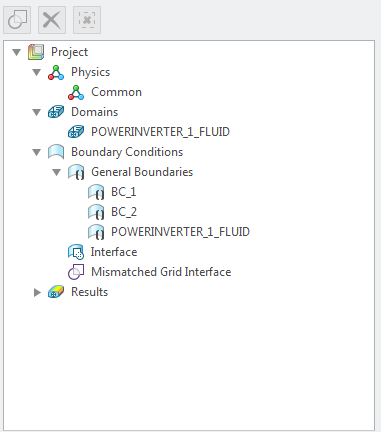Power Inverter without Heat Transfer: Exercise 1—Extracting the Fluid Domain
1. Click Home > Select Working Directory and navigate to the FlowAnalysisModels folder. Click OK.
2. Click
File >
 Open
Open.
3. From the File Open dialog box, browse to the power_inverter_assembly_creo folder and select powerinverter.asm. Click Open.
4. Click

in the Graphics toolbar to display the style elements. Select
 Shading
Shading, or
 Shading with Edges
Shading with Edges.
5. Click the Applications tab.
6. Click
 Flow Analysis
Flow Analysis. The
Flow Analysis tab opens.
7. Click
 New Project
New Project. If the Residual plot opens, close it.
8. Click
 Create Fluid Domain
Create Fluid Domain. The
Fluid Domain Creation tab opens.
9. Select the Shrinkwrap check box.
10. Click the Openings tab.
11. Click the Faces box. The Surface Sets dialog box opens.
12. Press CTRL and select the two surfaces as shown below.
13. Click OK in the Surface Sets dialog box.
14. Click

.
15. Click
 Select Simulation Domains
Select Simulation Domains. The
Domain Model Selection box opens.
16. In the Domain Model Selection box, select Add fluid domain.
17. In the Model Tree select POWERINVERTER_1_FLUID.PRT. Middle-click to confirm. The fluid domain appears in the Domain Model Selection dialog box under Fluid Components.
18. Click OK. The fluid domain appears in the Flow Analysis Tree as POWERINVERTER_1_FLUID.PRT. Boundaries for the boundary conditions BC_1, BC_2, and POWERINVERTER_1_FLUID_DOMAIN are automatically created. They appear in the Flow Analysis Tree under General Boundaries in the Boundary Conditions area.
19. Under
Domains, right-click
POWERINVERTER_1_FLUID_DOMAIN and select
 Add Boundary Condition
Add Boundary Condition. The
Surface Sets dialog box opens.
20. Press CTRL and select the nine surfaces on the upper side of the inverter as shown in the figure below.
21. Click OK. Under General Boundaries a new entity BC_3 is created.


 Open.
Open. in the Graphics toolbar to display the style elements. Select
in the Graphics toolbar to display the style elements. Select  Shading, or
Shading, or  Shading with Edges.
Shading with Edges. Flow Analysis. The Flow Analysis tab opens.
Flow Analysis. The Flow Analysis tab opens. New Project. If the Residual plot opens, close it.
New Project. If the Residual plot opens, close it. Create Fluid Domain. The Fluid Domain Creation tab opens.
Create Fluid Domain. The Fluid Domain Creation tab opens.
 .
. Select Simulation Domains. The Domain Model Selection box opens.
Select Simulation Domains. The Domain Model Selection box opens. Add Boundary Condition. The Surface Sets dialog box opens.
Add Boundary Condition. The Surface Sets dialog box opens.